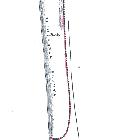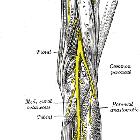piriformis muscle









The piriformis muscle is a muscle of the posterior pelvic wall and gluteal region of the lower limb. It is an important anatomical landmark.
Summary
- origin: sacrum
- course: exits the pelvis through the greater sciatic foramen
- insertion: greater trochanter of the femur
- action: abduction and lateral rotation of the thigh
- arterial supply
- innervation: nerve to piriformis (L5, S1, and S2 nerve roots) from the sacral plexus
Gross anatomy
The piriformis is a flat muscle, pyramidal in shape, lying almost parallel with the posterior margin of the gluteus medius muscle and deep to the gluteus maximus muscle. It is situated partly within the pelvis against its posterior wall, and partly at the back of the hip joint. The pelvic surface and sacral plexus are covered by pelvic fascia.
Origin
The piriformis muscle originates from the anterior part of the sacrum by three fleshy digitations (middle three pieces of its own half and adjoining lateral mass, and also extending medially between the anterior sacral foramina) as well as from the superior margin of the greater sciatic notch, and to a lesser extent the sacroiliac joint capsule and the sacrotuberous ligament.
Course
The muscle passes out of the pelvis through and fills the upper part of, the greater sciatic foramen into the gluteal region.
Insertion
The piriformis exits the pelvis through the greater sciatic foramen to insert on the apex of the greater trochanter of the femur.
Its tendon often joins with the tendons of the superior gemellus, inferior gemellus, and obturator internus muscles prior to insertion.
Relations
The sacral plexus is formed on its anterior surface.
Structures also passing through the greater sciatic foramen pass either above or below piriformis:
- passing superiorly: superior gluteal nerve and vessels
- passing inferiorly: inferior gluteal nerve and vessels; sciatic nerve; internal pudendal artery; pudendal nerve; posterior femoral cutaneous nerve; nerve to obturator internus; nerve to quadratus femoris
Arterial supply
- superior gluteal artery
- inferior gluteal artery
- lateral sacral artery
Innervation
- nerve to piriformis (L5, S1, S2)
Action
Lateral rotator of the hip with hip extension and abducts the femur with hip flexion.
Variant anatomy
- can be fused or partially fused with the gluteus medius, gluteus minimus or superior gemellus muscles
- can be inserted into the capsule of the hip joint
- may have only one or two sacral attachments at its origin
- when the sciatic nerve bifurcates prior to exiting the greater sciatic foramen, the piriformis is frequently pierced by the common peroneal (fibular) nerve
An accessory piriformis muscle, which is really accessory muscle slip(s), has been rarely described with considerable variability :
- accessory muscle slips covering sacral foramina / sacral nerves
- two distinct muscle bellies fusing to form a common tendon
- accessory slips arising from the sacrotuberous ligament or gluteus medius fascia
- three muscle bellies
- accessory slip arising from the main muscle belly with a separate tendinous insertion into the greater trochanter
Radiographic features
Ultrasound
- appears as a hyperechoic line between the greater trochanter and the lateral sacrum with the gluteus maximus muscle overlying it and the hypoechoic sciatic nerve lying deep
History and etymology
From the Latin "piriformis", meaning pear-shaped.
Related pathology
Siehe auch:
und weiter:

 Assoziationen und Differentialdiagnosen zu Musculus piriformis:
Assoziationen und Differentialdiagnosen zu Musculus piriformis:

